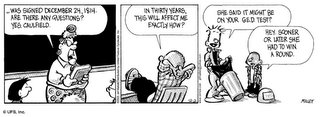Anyone who reads this blog regularly knows that I've long been a
quest to find reliable data on what's actually going on in the classroom. My hypothesis being that the Standard Operating Procedure is tremendously more traditional than we'd like to think -- a proposition which the TIMSS video study and NAEP teacher/student surveys seem to back up. Another wrinkle in the puzzle comes from the 2005 release of the
High School Survey of Student Engagement, a rich databank of 200,000 student responses drawn together by a research team at the University of Indiana. It's a hugely informative source from the standpoint of determining both student behavior and student perceptions. And, thanks to the short nature of the survey and the fact that high schoolers correlate reliably with teacher responses on NAEP surveys (as opposed to the lower grades), the data can be reasonably taken as valid.
What emerges from parsing through the numbers is a picture of traditional, lecture-and-worksheet high schools which aren't particularly rigorous, don't engage students nearly enough and don't create an environment where students feel supported or see connections between their work and the real world.
RigorA third of high schoolers surveyed reported that they spent 0-3 hours per week preparing for school, and fully 80% said that they spent less than 3 hours per week reading assigned materials. Yet, the strong majority of respondants were getting primarily As and Bs, and 81% said they often or very often came to class with assignments completed. In other words, most high schools are assigning work that can be done quickly (read: worksheets) and are not holding students to a high standard of expectation.
Even students recognize this fact -- a mere half indicated that they were being challenged to do their best work.
Student interactionDespite what those who think American classrooms are awash in constructivist paradise would have you believe, "42% of students said that they never or only sometimes worked on a paper or project using information from several sources, such as books, interviews, Internet, etc." Moreover, a third don't often or very often work with other students on projects or assignments during class, and only 57% said they frequently contribute to class discussions.
This, again, squares with the findings of both the TIMSS and NAEP studies; only about half of high school English teachers report doing group projects only once or twice a month, while in 8th grade math classes, the teacher talks on average 85% of the time. The fact is that all evidence points to traditional pedagogy continuing to dominate the classroom.
Student take-away
An often overlooked question is that of what students are walking away from the classroom with. Certainly social norms and context affect this data more than other items, but it simply cannot be discounted on those grounds alone. In fact, too many -- far too many -- students seem bewildered as to the point of school, a feeling that can't be advantageous for learning.
Only two-thirds of students indicate that they put a high value on learning (a scary stat if ever there was one) and never above two-thirds indicate that they thought their school experience contributed substantially to their skills. More specifically, only half said it contributed substantially in "learning work-related skills" and only 45% for "solving real-world problems." Which begs the question, if you're in the other half, what precisely is your incentive for working hard?
The lost thirdI've noticed in my studies that one number keeps coming up -- 33%. There seems to be a third of students who simply can't buy in to the often bizarre system, and, not accidentally I think, that third comes awfully close to meeting the 70% national graduation rate. Take this, for example: 37% of students were neutral, disagreed or strongly disagreed that they "feel supported and respected by teachers," and the more negative responses to that question correlated with lower rates of taking pride in schoolwork, thinking what they learn is useful, feeling challenged, etc. Reiterating from above, a third of students don't put a high value on learning.
I'd be curious to know if any specific studies were done on this phenomenon of the lost third, because it certainly seems like there's a profile that students in this segment meet, and it's a profile whose natural conclusion is, alarmingly, dropping out of high school.
-------
Only meaningful school reform is going to bring about serious change in these numbers. Currently, the high school is seen as dysfunction across the board and across the aisle, and via studies like the HSSSE, we can draw a detailed blueprint of that broken institution. What comes next is not being satisfied with our picture and not being satisfied with tweaks or new programs; what comes next is identifying the functional parts of the current system, using them as a foundation (along with recent advances in accountability and infrastructure), and then raising a new high school, a new public school, from the ashes.
The story of the latter half of the 20th century was school reform, but not pedagogical reform. I've said it before, and I'll say it again -- time to put up the walls.
